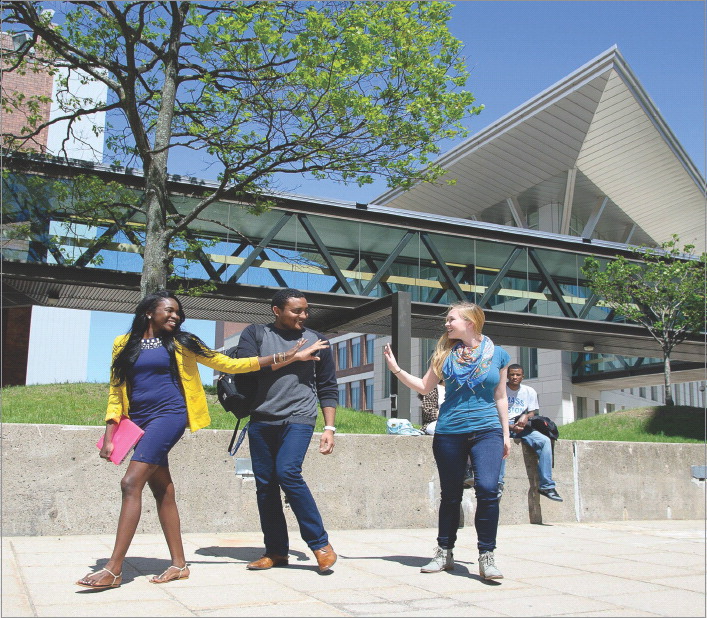
Partnerships to accelerate globalization on campus
Changing demographics, a volatile political climate, and financial pressures on higher education weigh on the minds of college and university administrators as they struggle to make sense of, and plan around, these external forces. The most logical response is to seek ways to expand upon the campus mission, increase enrollment, and find new sources of revenue. Accelerating international efforts is a strategy that addresses all three of these goals.
As part of the campus internationalization plan, many universities are engaged in recruiting international students as a key strategy to both internationalize the campus and secure a steady stream of income. In this effort, campuses increasingly are turning to education companies as partners to recruit, support, and retain international students. Most often, these third-party providers partner with the campus to create pathway programs for first-year students or develop pre-masters programs to ease the path into graduate school.
In many countries, international students have come to trust the providers that have been around for decades and weathered previous political issues in Australia, Asia, the UK, Canada, and the U.S. By partnering with third-party providers, campuses immediately secure the recruiting networks and connections companies have developed over many years, enabling them to add international students much more quickly and from many more countries than they could using their own recruitment staff. More recently, some universities are turning to well-established pathway providers to address the current uneasiness about the U.S. political situation.
This international outreach has domestic benefits as well. College and university leaders recognize that producing students with global competencies is necessary if those students are to work in an increasingly international business and education environment. The Organisation for Economic Co-operation and Development (OECD) estimates there will be 300 million 25–34 year olds with a higher education degree by 2030, and the U.S. will account for only 8 percent of that group. Already China is ahead of the U.S., with 17 percent of the 25- to 34-year-old population having a higher education degree compared to 14 percent in the U.S. and 14 percent in India (2015).
Historically, campuses addressed internationalization and global competencies by supporting study abroad experiences—often for a select sub-set of students—and accepted highly qualified international students, mostly at the graduate level. In both cases, there have been dramatic changes. Today many domestic students are challenged financially and can’t take advantage of study abroad experiences. In fact, in spite of long-standing successful programs, only 1.6 percent of U.S. students and 3.1 percent of Canadian students study abroad (Bataille and Waterhouse, 2016).
Bringing international students to study at U.S. campuses is increasingly viewed as the best option to globalize the campus. International student enrollment has continued to grow. The most recent enrollment data from the Open Doors report estimated that one million international students were studying in the U.S. in 2015 (2016). The Student and Exchange Visitor Information System (SEVIS) reported that number was up to 1,180,000 in the spring of 2017 (2017).
Still, the U.S. lags behind other countries in providing opportunities for international students, particularly at the undergraduate level. International students comprise about 11 percent of university enrollment in Canada and about 14 percent in the UK. In Australia, international students are about 25 percent of total enrollment, making international education Australia’s second-largest export industry. In the U.S. that figure is about 5 percent (Brains without borders, 2016).
Although the one million international students studying in the U.S. in 2015 represents an increase of 7 percent over the previous year, these students are not dispersed evenly among the over 4,500 U.S. institutions. Nearly 117,000 students were concentrated at 10 campuses last year, and the vast majority of the remaining students were enrolled at just 5 percent of U.S. institutions. In the U.S., about 41 percent of the international students are undergraduates, and 37 percent are graduate students, with non-degree and post-graduate students making up the remainder (International student enrollment trends, 2016).
The Open Doors data show that, despite recent increases, the U.S. market share of international students is in decline. In 2000, 22.9 percent of international students were studying in the U.S.; today, that figure is 19 percent (2016). In the spring of 2017, the American Association of Collegiate Registrars and Admissions Officers (AACRAO) reported that 39 percent of surveyed institutions reported declines in international applications for fall 2017. By late spring of 2017, however, several campuses reported increases in international student applications, but many of the campuses seeing increases were high-ranking institutions and often located in key areas such as Boston and Silicon Valley.
Throughout the summer of 2017, multiple surveys attempted to determine how many international students would arrive on U.S. campuses in September. Literally, the jury is still out on what might happen; the Supreme Court’s ultimate ruling on the travel ban is likely to affect these numbers. International students are and will be speculating on what the final decisions might mean for their educational futures.
Political actions and proposed policies are driving more international students to Canada and Australia and away from the U.S. and the UK. In March 2017, Australian universities reported an increase of 15 percent in international students. Similarly, Canada has reported increases in international applications for the fall of 2017 at both the undergraduate and graduate levels. This coincides with a 26.8 percent decline in 2016 in the number of student visas granted for study in the U.S. Some students also have cited the uncertainty about the future of the H-1B visa program as a deterrent to studying in the U.S. (International student numbers up 15% on last year, 2017).
As early as January 2017, American Council on Education (ACE) President Molly Corbett Broad and 46 other leaders of higher education institutions acknowledged the challenges campuses were facing as a result of the January 2017 Executive Order (Letter to The Honorable John F. Kelly, 2017). So far it is not easy to predict how the political environment will affect international student decisions about their future, but early evidence suggests that the changes will not be uniform across all higher education institutions.
Increasing Student Mobility through Pathway Programs
In June of 2017, ACE released Mapping Internationalization on U.S. Campuses, the compilation of survey responses from 1,164 higher education institutions. Overall the report documented that universities have increased their focus on student mobility, tracking both U.S. students studying abroad and international students seeking a U.S. education. Respondents also reported that campus leadership has an increased concern about the level of support international students receive before and after they arrive on campus.
For the first time, ACE queried respondents about global success programs and pathway programs designed to recruit, retain, and graduate international students through formal programming, whether managed internally or in partnership with an external company. Overall, 49 percent of respondents indicated the institution was operating, developing or considering an intensive English program, with 32 percent operating, developing or considering a pathway program (2017).
Full pathway programs at the undergraduate level are designed to recruit international students and provide them with a specialized first year of study to set students up for success. They address English proficiency if needed and provide cultural and academic orientation while students complete a year of academic coursework. Although they are sometimes included in the counts of pathway programs, those programs that focus only on English language learning are not full pathway programs and generally serve as just one step along the way to full matriculation into a college or university. Full pathway programs typically include both credit and non-credit instruction, tutoring, social and cultural support, and overall orientation to the university. These programs are designed to prepare students for entry into mainstream academic programs, to increase retention and graduation rates and, most important, to lead to student success.
The movement toward working with external providers continues to increase. More and more universities are moving in the direction of establishing formal programs to support international student success through partnerships that help the campus gain access to expanded recruitment and a stream of resources to support international programs as well as enhance overall campus globalization efforts. In a recent NAFSA: Association of International Educators study of third-party pathway providers, Rahu Choudada documented that in 2016 there were 45 U.S. institutions with established partnerships and that number is growing (2017).
These programs came late to North America. Beginning in Australia in 1994, Navitas was the first private education company to develop university pathway programs for international students. These programs were designed to provide quality academic experiences for international students at both the undergraduate and graduate levels. From that beginning, there are now multiple companies worldwide seeking partnerships with colleges and universities to recruit and support international students. Some familiar names among the providers are Cambridge Education Group, INTO, Kaplan, Kings Education, Navitas, and Shorelight. Many education companies are adding pathways to the services they offer along with other education support efforts, so this segment of education provided by external providers continues to grow.
Canada started its first full pathway program in 2006, and about 30 percent of international students come to Canadian universities through pathway programs. There are roughly 10,600 students in Canadian pathway programs now, with the expectation that by 2020 there will be 17,500 students coming through Canadian pathway programs. About half of these students are coming through English language programs alone and are not enrolled in a full academic pathway program. Even before the changing political climate, Canada and the UK enrolled over double the percentage of international students as the U.S. While the U.S. continues to have the highest number of international students, the percentage of total enrollment is declining for many reasons, among them an increasing focus on nationalism and uncertainty about U.S. policies (Bataille & Waterhouse, 2016).
As campuses consider pathway programs, faculty will be interested in the academic quality of the pathway program and are essential participants in the conversations. International students recruited into pathway programs will take the same courses as domestic students, most often in separate sections and with additional contact hours, and the expectations for academic success will be set by the campus faculty. Faculty who teach in the program are selected by and hired by the campus but compensated by the external partner. Campuses should request data from potential providers on student retention and graduation success rates as well as comparisons of pathway student success with the success of international students who were directly admitted. Joint academic committees between the partners will ensure that academic rigor and quality are evaluated on a regular basis.
Benefits of Pathway Programs
Few question the benefits of having international students on campus. For domestic students, being in classes with international students has the potential to provide them with an international experience without leaving home. With a critical mass of international students on a campus, events such as Chinese New Year and Diwali bring international experiences to all students. Working in groups with students from other countries readies all students to participate in global affairs and prepare for the diverse workforce they will enter.
Pathway programs support the globalization of campuses through the diversity of students, the expansion of the curriculum, and broader opportunities for faculty and staff. Working in partnership with senior administrators on the campus, pathway program providers are committed to the mission and goals of the partner campus. Pathway programs have the ancillary effect of an expanded revenue stream for the institution that allows the campus partners to expand services and opportunities for all students.
Faculty members engaged in teaching international students often find their own perspectives about their discipline and the world change when international students challenge the curriculum or their lectures. Confronted with how an international student might react to their U.S.-centric or Euro-centric views, faculty members have the opportunity to approach subject matter in a different way. Staff members, whether directly engaged with international students or simply being aware of their presence, become more attuned to the support needs of students who bring with them their own cultural values and habits of being. Additionally, international faculty members are often drawn to a campus with a richly diverse international student body, further internationalizing the campus.
There are other ancillary benefits of pathway programs that are seldom mentioned. The intense learning environment and specialized curriculum (as well as constant monitoring of students) that are central to pathway programs can serve as a model for success programs for domestic students who are first-generation students or whose first language is not English. Campuses also benefit from the branding that comes with having international students return home wearing ball caps and t-shirts advertising the campus and who encourage other family members to attend college in the U.S. Advancement officers have quickly learned that satisfied and successful international graduates are grateful for the support of the university and are likely to become donors. Faculty members who have worked with international graduate students find that these students often become collaborators on research when they return to positions in their home countries. When the entire campus is engaged in the globalization effort, everyone benefits.
Institutions also benefit financially from having international students on campus through financial arrangements set up as joint ventures or shared tuition revenue models. Students pay full non-resident tuition as well as all ancillary fees, resulting in a steady stream of new income for campuses. Local communities and the larger economy also see increased spending from students who choose to study in the U.S. The most recent Open Doors study reports that international students contributed more than $35.8 billion to the U.S economy in 2015 (2016).
About 75 percent of all international students receive the majority of their financial support from outside the U.S., whether it is family support or sponsorship from their home country (Open Doors, 2016). These students are thus not a drain on financial aid or other campus support. Additionally, those students who choose to stay in the country where they were educated add talent to the workforce, representing a significant brain gain.
Partnerships that increase the number and quality of international students on a campus provide opportunities for student academic and career success. Many students will return to their home countries prepared to live, to work, to lead, and to better understand the world. Others will remain for a short or longer period in the country where they were educated, contributing to the economy, to the creation of new knowledge, and to a better global understanding for communities and countries.
Higher education administrators and thoughtful political leaders recognize that every country benefits from opportunities to share languages, religions, customs and cultures across boundaries. University leaders have been outspoken about the benefits of internationalizing their campuses and have openly resisted actions such as the travel bans. Recent research and actions support the movement toward an increased focus on internationalizing campuses through active recruitment of international students.
Addressing the Challenges of International Recruitment
There are a number of factors influencing international students and their families as they make choices about where to study. Many of these students are first-generation college students, and often no one in their family has traveled or studied abroad; coming to the U.S. is a big step for them. Increasingly, parents and families of international students are becoming concerned—about possible travel bans, but also about what they learn in the news about hate crimes, guns on campus, and stereotyping that has led to violence on some campuses and in some communities.
University decisions to engage a third-party provider are often not a simple matter either. U.S. universities and state governments often have policies in place that limit opportunities to establish third-party partnerships. Given the current state of suspicion and fear from many quarters about those who are ‘different’, some proposed national policies threaten opportunities for colleges and universities to recruit international students. On campuses, even the faculty most committed to internationalization may be suspicious of third-party providers, fearing interference with the curriculum, or concerned about who will be teaching the for-credit courses.
Although many colleges and universities have explored opportunities to partner with education companies offering recruitment and support services, there is often limited knowledge on campus about how international students access higher education abroad. Isolated stories about disreputable agents often lead to suspicion and confusion, making campus leaders reluctant to explore partnerships.
Those campuses that use agents or partner with a company to recruit and deliver students often find that some of the work of enrolling international students can be made less burdensome. Visa requirements are becoming lengthier and more cumbersome for students, and the rejection rates and processing times often keep a student from enrolling. Companies that specialize in recruiting international students know the agents and work with the reliable ones, have close relationships with embassies and visa officers, and are familiar with the quality of in-country schools and know how to interpret transcripts.
In their home countries, agents can and do play an important role in helping potential students and families to understand a complex global market in higher education. However, there is some distrust of agents and their motives in the U.S. academic environment, even though the majority of agents are trustworthy and committed to finding the right institution for their clients. A few years ago there was a debate about the use of agents and the National Association for College Admission Counseling (NACAC) lifted its prohibition on the practice of using agents after two years of careful deliberation on the issue. Recently, the Middle States Commission on Higher Education proposed new policies that would prohibit incentive-based compensation for international student recruitment, an action that has baffled those who have followed this issue for years.
Establishing and maintaining a clear view and understanding of the role agents is thus still a challenge in international recruitment efforts. In many countries, it is nearly impossible for students to find an international university without working with an agent, and they will continue to do so whether or not the university engages agents. By accepting agents as partners, universities have control over agents and can work with them to ensure they are sending qualified students.
A company that has multiple regional offices abroad is likely to be able to deliver a broad range of nationalities and can weather the intermittent challenges brought on by natural disasters and political machinations. New challenges are always on the horizon, but many international education companies have partnerships throughout the world and have dealt with the changing policy environments, making such companies attractive during difficult political times.
Conclusion
Seventy-two percent of respondents to the ACE Mapping survey reported an increase in the emphasis on internationalization on their campuses, citing the desire to improve domestic students’ preparedness for a global environment, to diversify the campus at all levels, to become more attractive to both domestic and international students, and to generate needed revenue for the campus. In spite of the benefits described for internationalization, fewer than half of the responding institutions indicated that internationalization was a priority in the campus strategic plan or mission statement (2017).
This dichotomy is not surprising. Higher education is forward-looking but often slow to change, and each campus needs to assess its own strategic plan for internationalization. There are often fears about working with an external for-profit company or concerns that extensive recruiting of international students may result in replacing domestic students. Not all campuses are ready to expand the numbers of international students because of their basic infrastructure, political realities, or lack of institutional commitment.
But none of this changes the reality now facing college campuses and their leadership. We live in a global society and university students—wherever they come from—will live in a world that will demand that they understand how to live and work together.
It’s easy—and it would be a mistake—to think about recruiting international students only in terms of economic impact. Certainly there is an economic benefit; the $35 billion added to the U.S. economy reflects an average of over $34,000 per student. Additionally, universities benefit from the tuition revenue these students bring to campus.
But international students contribute much more than the tuition dollars they bring to our colleges and universities. International students are often the key to a campus’s’ globalization strategy, adding intellectual, political, and cultural diversity to the campus. The potential of a slowing growth rate in numbers of international students, coupled with concerns about immigration policies under the current administration, means that we are at risk of losing the benefits derived from having a robust population of international students on our campuses.
A campus contemplating a comprehensive globalization initiative has work to do ahead of time. The campus needs to do its own assessment initially and consider many questions—what are the campus internationalization goals, what mechanisms are already in place on campus such as contracted agents and international recruiters, what is the reputation of the companies seeking partnerships, and what is the level of administrative commitment to the partnership (Evaluating international student pathway programs, 2017).
Similarly, companies will be assessing the campus—what does the location contribute to the ability to recruit, are the academic programs aligned with what international students want to study, how much is the non-resident tuition, what will the costs be for the students and will the ranking of an institution have a positive or negative effect on recruitment? But, most important, providers will take note of the commitment of the institution’s senior leadership as well as the board of trustees.
The world benefits when colleges and universities partner with experts who know how to provide added value to the campus through recruitment and retention of international students. Other advantages to partnering with a known and successful pathway provider include access to regional offices throughout the world that can provide services to visiting faculty and administrators and often set up interviews and meetings that can enhance the campus brand. Just as partnerships with Silicon Valley companies and regional businesses benefit students, enhance the curriculum, and produce graduates ready to take on new challenges, partnerships to build international student pathway programs provide the geographical diversity most campuses seek as well as a revenue stream that can help address financial uncertainty on campuses.
This article was first published online in Change: The Magazine of Higher Learning on January 3, 2018.
REFERENCES
- International student applications decline, concerns about visas and U.S. political climate rise (14 March 2017).
Retrieved from https://www.aacrao.org/resources/newsletters-blogs/aacrao-transcript/transcript/international-student-applications-decline–concerns-about-visas-and-u-s–political-climate-rise - Letter to The Honorable John F. Kelly, Secretary of Homeland Security (31 January 2017).
Retrieved from http://www.acenet.edu/ news-room/Documents/ACE-Letter-to-DHS-John-Kelly-International- Students-Scholars.pdf - Mapping internationalization on U.S. campuses (2017).
Retrieved from http://www.acenet.edu/news-room/Pages/ACE-Releases- Signature-Mapping-Internationalization-on-U-S-Campuses-Report.aspx - Bataille, G. & Waterhouse, J (2016). Gaps in achieving campus goals for internationalization.
Retrieved from http://www.acenet.edu/news- room/Pages/Gaps-in-Achieving-Campus-Goals-for-Internationalization-. aspx - Brains without borders, The Economist (30 January 2016).
Retrieved from http://www.economist.com/news/international/21689540-australia- and-canada-seek-attract-more-foreign-students-america-and-britain- could - Choudada, R. – Landscape of third-party partnerships in the U.S. NAFSA (2017).
Retrieved from http://www.nafsa.org/Shop/detail. aspx?id=160E - Evaluating international student pathway programs (2017).
Retrieved from navitas.com/nafsa - International student enrollment trends, 1948/49-2015/16. Open Doors Report. Institute of International Education (2016).
Retrieved from https://www.iie.org/opendoors - International student numbers up 15%, University World News (23 June 2017).
Retrieved from http://www.universityworld news.com/article.php?story=201705261322338&query=International+ student+numbers+up+15%25 - Education indicators in focus (April 2015).
Retrieved from http://www.oecd.org/education/EDIF%2031%20(2015)–ENG–Final.pdf - Redden (20 March 2017) Canada’s moment. Inside Higher Education.
Retrieved from https://www.insidehighered.com/ news/2017/03/20/canadian-universities-post-large-gains-international- applications - SEVIS by the numbers: biannual report on international student trends (June 2017).
Retrieved from https://www.ice.gov/doclib/sevis/ pdf/byTheNumbersJun2017.pdf - Surveys split on outlook for international enrolment, University World (6 July 2017),
Retrieved from http://www.universityworld news.com/article.php?story=20170706182942499




